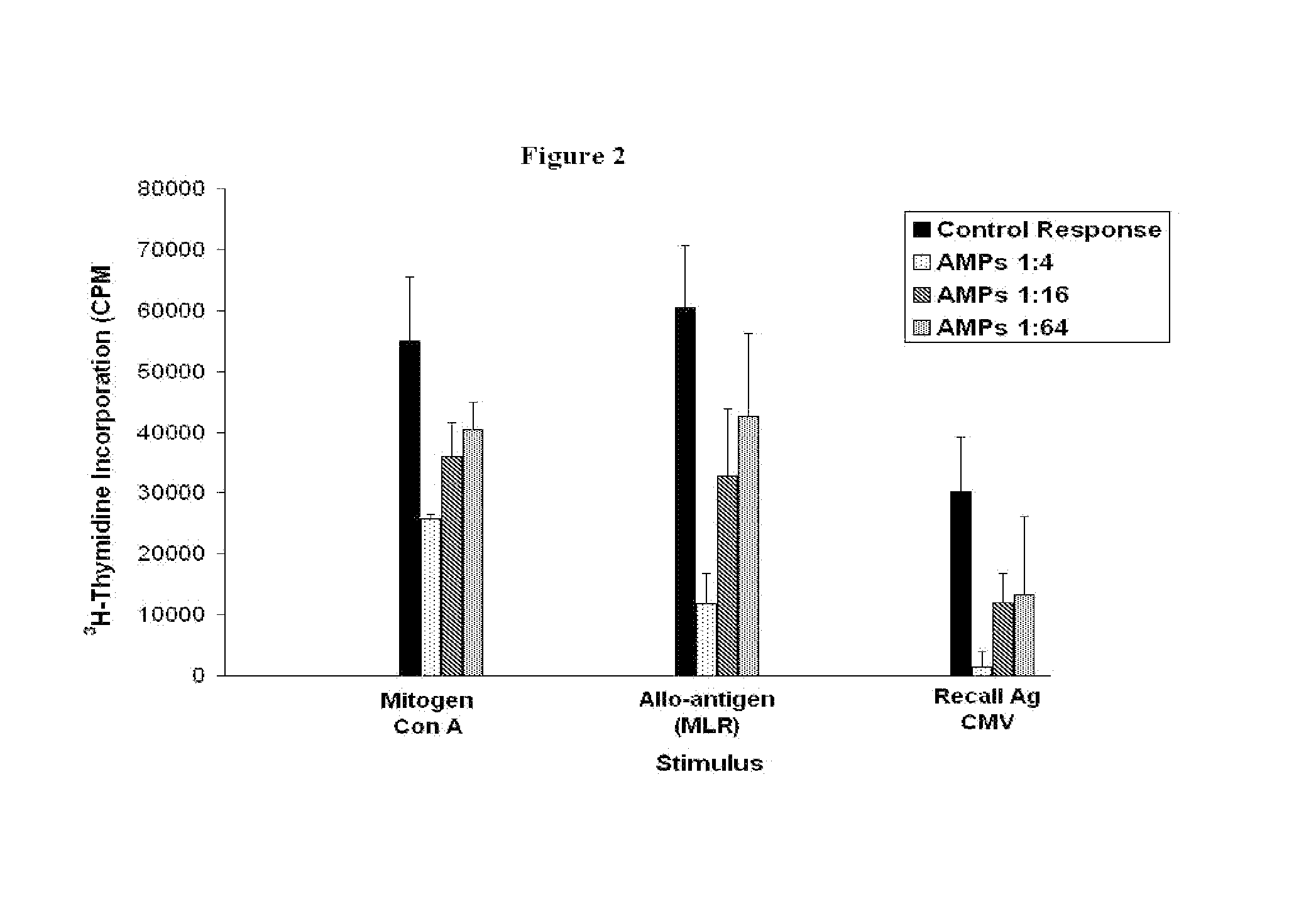Methods for modulating inflammatory and/or immune responses
a technology of immune response and inflammatory response, applied in the direction of antibody medical ingredients, peptide/protein ingredients, drug compositions, etc., can solve the problems of hvg rejection, a large morbidity and mortality, chronic graft rejection remains a major source of morbidity and mortality, etc., to achieve the effect of suppressing, preventing, reducing or treating hvg, and being readily available in large numbers
- Summary
- Abstract
- Description
- Claims
- Application Information
AI Technical Summary
Benefits of technology
Problems solved by technology
Method used
Image
Examples
example 1
Characterization of Amnion-Derived Multipotent Progenitor (AMP) Cells Used in Studies
[0163]For immunological studies, a further characterization of the cell surface markers of AMP cells, a distinct sub-population of cells isolated from human amnion that have been cryopreserved, cultured, and propagated, was performed before examination of their immunological characteristics. Under these conditions, AMP cells are negative for the CD117 antigen (c-kit), distinguishing AMP cells from amniotic fluid-derived cells, and are ˜74% positive for CD90 and ˜97% SSEA-4. AMP cells also exhibit staining for CD9 (˜81%), CD10 (˜64%), CD29 (˜100%), CD104 (˜100%), CD49f (˜100%), CD105 (˜12%) and CD44 (˜7%), but are negative for hematopoietic markers CD34 and CD45 and for the PDGF receptor CD140b. Further analysis was performed to establish a relevant immunological profile for AMP cells. AMP cells expressed MHC class I molecules, however were negative for MHC Class II. AMP cells were also negative for ...
example 2
Immunogenicity of AMP Cells: Mixed Lymphocyte Reaction (MLR). Normal Peripheral Blood Mononuclear Cells vs. HLA-DR (Class II) Mismatched AMP Cells
[0164]HLA-G is a non-classical major histocompatability complex (MHC) class I molecule that has a tissue-restricted distribution. It has been shown to provide materno-fetal tolerance and is expressed on cytotrophoblasts at the fetal-maternal interface. HLA-G is also expressed by certain cancer lineages, where it may have a role in providing an escape mechanism to the immuno-surveillance of the host organism. It has been shown (CMLS, 55, 1999, 327-333, incorporated by reference herein) that HLA-G can inhibit MHC-restricted (T-cell) and unrestricted (NK cell) responses through Killing Inhibitory Receptors (KIR) expressed on the T-cell and NK cells. This includes lytic as well as proliferative responses. Therefore, HLA-G has immunomodulatory properties of the cells expressing it and of the environment in which these cells are located.
[0165]Ap...
example 3
Immunomodulatory Effects of AMP Cells: Mitogen Response, Mixed Lymphocyte Reaction, and Antigen-Specific Memory Response to Cytomegalovirus (CMV)
[0170]Normal PBMCs respond vigorously to stimulation with the mitogen Concanavelin A (Con A) in a three day culture. To assess the immunomodulatory effects of AMP cells on Con A stimulation, various concentrations of AMP cells were titrated into the assay. Briefly, PBMCs were cultured at 1×10^5 cells per well in a 96-well round bottom tissue culture plate (BD Falcon, Cat. #08-772-5) in the presence of 10 μM Con A (Sigma, Cat. # C5275). The cultures were incubated at 37° C. in a humidified 5% CO2 incubator for 2 days, then pulsed overnight with 1 μCi tritiated thymidine (3H-dTR, Perkin Elmer, Waltham, M A) to measure T cell proliferation. Cultures were then harvested using a Mach III 96-well cell harvester (Tomtec, Hamden, Conn.) and counted using a Microbeta scintillation counter (Wallac Inc., Gaithersburg, Md.). The results were expressed ...
PUM
| Property | Measurement | Unit |
|---|---|---|
| pore size | aaaaa | aaaaa |
| composition | aaaaa | aaaaa |
| plasma membrane | aaaaa | aaaaa |
Abstract
Description
Claims
Application Information
 Login to View More
Login to View More - R&D
- Intellectual Property
- Life Sciences
- Materials
- Tech Scout
- Unparalleled Data Quality
- Higher Quality Content
- 60% Fewer Hallucinations
Browse by: Latest US Patents, China's latest patents, Technical Efficacy Thesaurus, Application Domain, Technology Topic, Popular Technical Reports.
© 2025 PatSnap. All rights reserved.Legal|Privacy policy|Modern Slavery Act Transparency Statement|Sitemap|About US| Contact US: help@patsnap.com



